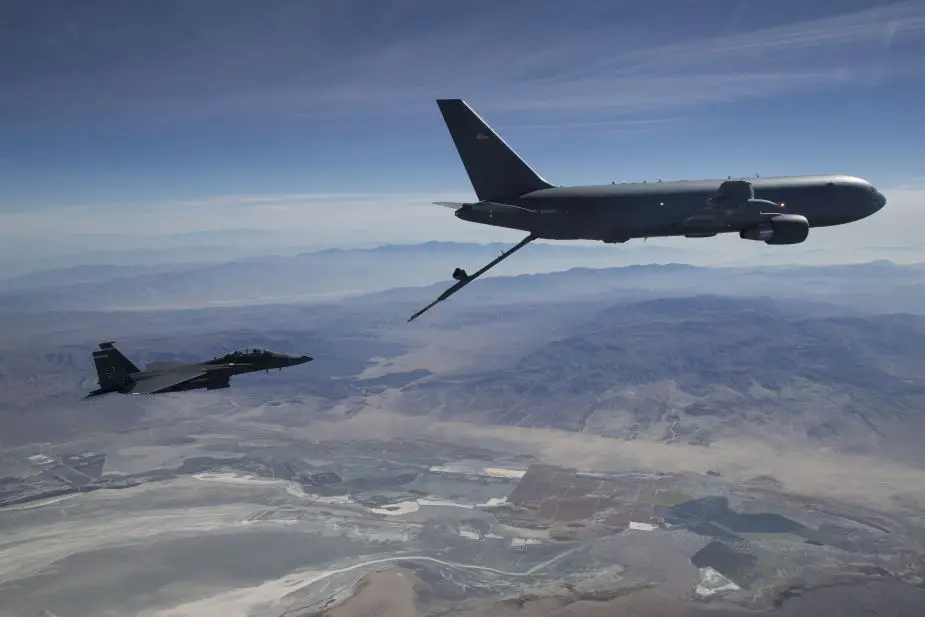A KC-46A from the 22nd Air Refueling Wing of US Air Force completed the Pegasus’ first flight around the world on November 13-26, 2019. The first global circumnavigation for the KC-46A Pegasus provided extensive training opportunities for maintainers and aircrew at multiple locations on a seven-leg, 13-day journey that included its debut at the 2019 Dubai Air Show (DAS).
 The KC-46A Pegasus represents the beginning of a new era in aerial refueling, providing vital capability to the U.S. Air Force and joint partners. (Picture source U.S. Air Force photo by Master Sgt Michael Jackson)
The KC-46A Pegasus represents the beginning of a new era in aerial refueling, providing vital capability to the U.S. Air Force and joint partners. (Picture source U.S. Air Force photo by Master Sgt Michael Jackson)
The KC-46 is currently conducting operational testing and evaluation as it prepares to serve as the next generation air refueling platform for the Air Force. The global mission was an important milestone, offering an opportunity for allies and partners to see first-hand one of the Air Force’s newest weapon systems, and hear the unique perspectives of those who operate and maintain the KC-46.
“Our operators and maintainers had the privilege of circumnavigating the globe in the Air Force’s newest and most capable air refueling platform,” said Col. Thad Middleton, 22nd Operations Group commander and subject matter expert for the flight. “We have worked with our partners at the Tanker Airlift Control Center on previous overseas missions, but our movement across the Atlantic, Indian Ocean and the South Pacific allowed us to truly flex the system. It goes without saying, but the crew members gained invaluable training in terms of oceanic procedures, unfamiliar airfield operations and dynamic mission planning.”
After a quick stop at Royal Airfield Mildenhall, England, the support team of 14 Airmen traveled to the United Arab Emirates to show off the Air Force’s newest weapon system as a static display in the 2019 DAS.
Debuting key aircraft such as the KC-46 allows the Air Force to promote regional U.S. national security objectives, showcase U.S. military hardware to partners in the region, and demonstrate contributions to regional stability.
During the airshow itself, the McConnell team shared their experiences on the KC-46 with airshow visitors and interested partners.
The DAS, considered the premier aviation and air industry event in the Middle East, featured 161 aircraft from around the world, 1,288 exhibitors, and resulted in over $54 Billion in aviation related deals. The U.S. military presence included nine airframes and over 300 personnel, up from the 250 personnel present at the 2017 DAS.
The KC-46A represents the beginning of a new era in air-to-air refueling capability for the joint force. The aircraft has been in development since Feb. 24, 2011, and its initial flight occurred in Dec. 2014. The current contract, with options, provides Air Mobility Command an inventory of 179 KC-46A tankers. The first KC-46A was delivered to McConnell Air Force Base, Kansas on Jan. 25, 2019. The aircraft is will soon undergo operational test and evaluation on the way to initial operating capability.
The KC-46A is the first phase in recapitalizing the U.S. Air Force's aging tanker fleet. With greater refueling, cargo and aeromedical evacuation capabilities compared to the KC-135, the KC-46A will provide next generation aerial refueling support to Air Force, Navy, Marine Corps and partner-nation receivers.
The KC-46A can accommodate a mixed load of passengers, aeromedical evacuation and cargo capabilities. Two high-bypass turbofans power the KC-46A to takeoff at gross weights up to 415,000 pounds. Depending on fuel storage configuration, the aircraft can carry a palletized load of up to 65,000 pounds of cargo. The KC-46A can carry up to 18 463L cargo pallets. Seat tracks and the onboard cargo handling system make it possible to simultaneously carry palletized cargo and passenger seats in a variety of combinations. The KC-46A is also equipped with a number of self-protection, defensive and communication features making it more survivable in a contested environment.
















